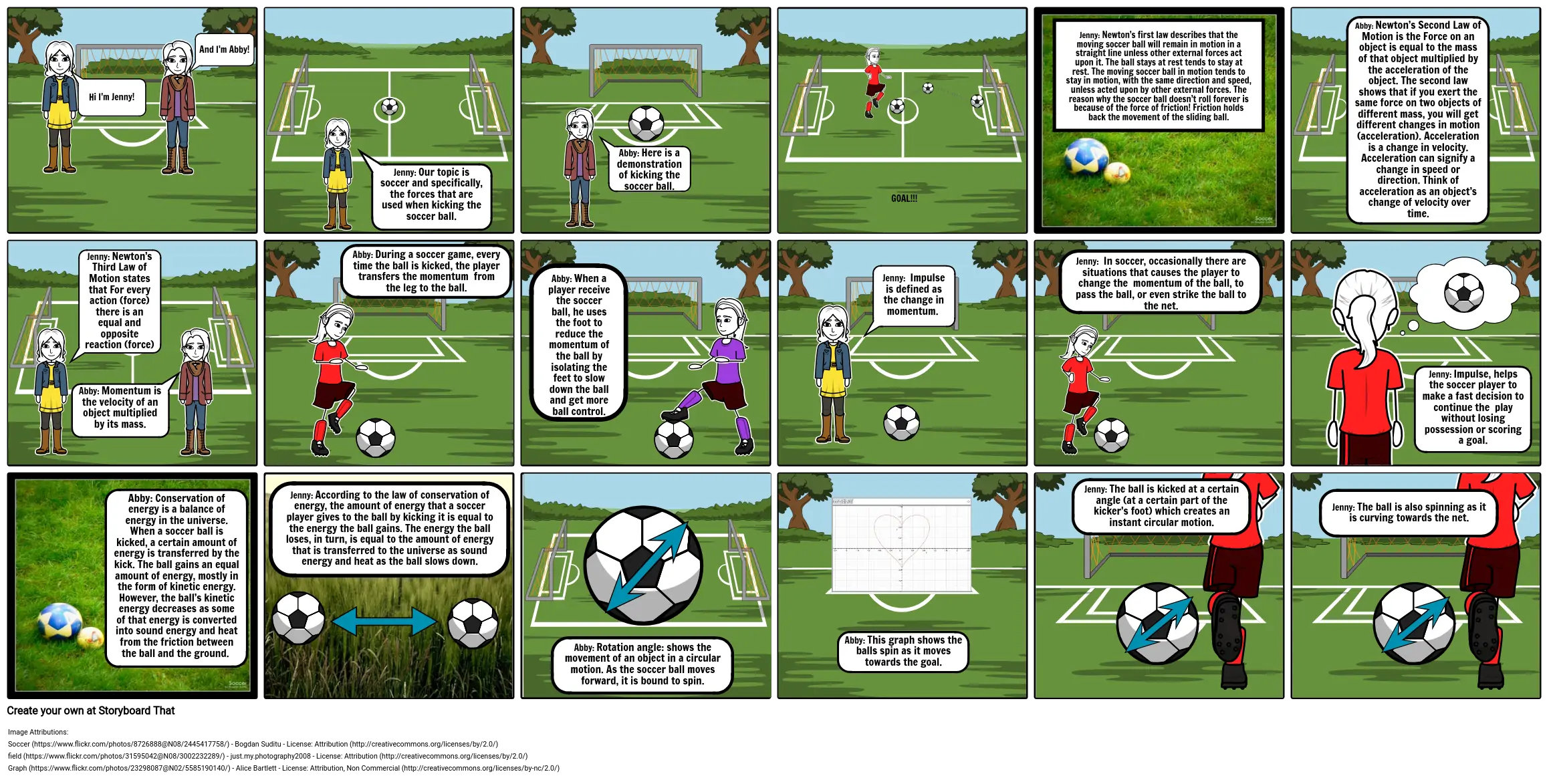Forces of Soccer

Storyboard Text
- Hi I'm Jenny!
- And I'm Abby!
- Jenny: Our topic is soccer and specifically, the forces that are used when kicking the soccer ball.
- Abby: Here is a demonstration of kicking the soccer ball.
- GOAL!!!
- Jenny: Newton’s first law describes that the moving soccer ball will remain in motion in a straight line unless other external forces act upon it. The ball stays at rest tends to stay at rest. The moving soccer ball in motion tends to stay in motion, with the same direction and speed, unless acted upon by other external forces. The reason why the soccer ball doesn’t roll forever is because of the force of friction! Friction holds back the movement of the sliding ball.
- Abby: Newton’s Second Law of Motion is the Force on an object is equal to the mass of that object multiplied by the acceleration of the object. The second law shows that if you exert the same force on two objects of different mass, you will get different changes in motion (acceleration). Acceleration is a change in velocity. Acceleration can signify a change in speed or direction. Think of acceleration as an object’s change of velocity over time.
- Jenny: Newton’s Third Law of Motion states that For every action (force) there is an equal and opposite reaction (force)
- Abby: Momentum is the velocity of an object multiplied by its mass.
- Abby: During a soccer game, every time the ball is kicked, the player transfers the momentum from the leg to the ball.
- Abby: When a player receive the soccer ball, he uses the foot to reduce the momentum of the ball by isolating the feet to slow down the ball and get more ball control.
- Jenny: Impulse is defined as the change in momentum.
- Jenny: In soccer, occasionally there are situations that causes the player to change the momentum of the ball, to pass the ball, or even strike the ball to the net.
- Jenny: Impulse, helps the soccer player to make a fast decision to continue the play without losing possession or scoring a goal.
- Abby: Conservation of energy is a balance of energy in the universe. When a soccer ball is kicked, a certain amount of energy is transferred by the kick. The ball gains an equal amount of energy, mostly in the form of kinetic energy. However, the ball’s kinetic energy decreases as some of that energy is converted into sound energy and heat from the friction between the ball and the ground.
- Jenny: According to the law of conservation of energy, the amount of energy that a soccer player gives to the ball by kicking it is equal to the energy the ball gains. The energy the ball loses, in turn, is equal to the amount of energy that is transferred to the universe as sound energy and heat as the ball slows down.
- Abby: Rotation angle: shows the movement of an object in a circular motion. As the soccer ball moves forward, it is bound to spin.
- Abby: This graph shows the balls spin as it moves towards the goal.
- Jenny: The ball is kicked at a certain angle (at a certain part of the kicker's foot) which creates an instant circular motion.
- Jenny: The ball is also spinning as it is curving towards the net.
Image Attributions
- field - just.my.photography2008 - (License Attribution )
- Graph - Alice Bartlett - (License Attribution, Non Commercial )
- Soccer - Bogdan Suditu - (License Attribution )
Over 30 Million Storyboards Created
No Downloads, No Credit Card, and No Login Needed to Try!
